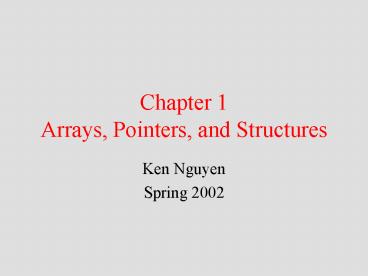Chapter 1 Arrays, Pointers, and Structures PowerPoint PPT Presentation
1 / 18
Title: Chapter 1 Arrays, Pointers, and Structures
1
Chapter 1Arrays, Pointers, and Structures
- Ken Nguyen
- Spring 2002
2
1.1 What are arrays
- Aggregate collection of objects stored in one
unit - Arrays indexed collections of identical-type
objects. - Pointers objects are used to access other
objects. - Structures collections of objects that need not
be of the same type.
3
1.2 Arrays and Strings
- Arrays can be used in two different ways
primitive arrays and vectors. - String in C is implemented in both structures.
- First class object(vectors) vs. second class
object (arrays)
4
Vectors
- include ltvectorgt
- Declaration vectorlttypegt identifiers(size)
- Example vectorltintgt a(3)
- Vector can be indexed as an array, using
- Vector member functions size, resize, push_back,
pop_back, . . .
5
Function calls
- Call by value
- int findMax(vectorltintgt a)
- Call be reference
- int findMax(vectorltintgt a)
- int findMax(const vectorltintgt a)
6
Arrays
- int a2 0,1
- // multidimensional arrays
- int b22 1,1, 2,2
- matrixltintgt x(2,3)
7
Strings
- include ltstringgt
- string s hello world!
- int size s.length()
- s.c_str() returns a \0 terminated primitive
character array.
8
1.3 Pointers syntax in C
- unary operator that returns the address of
the object. - Type identifier // pointer declaration
- int a 3
- int iPtr
- iPtr a // points iPtr to the memory
address of variable a. - iPtr 5 // what is the value of a ???(5)
9
Pointers Cont
- Precedence rules applied on pointer arithmetic
- int a 10
- int ptr a
- ptr 1 // ptr
- ptr // returns 11, and //adv. ptr to
the next //memory slot
a
10
ptr
11
ptr
ptr
11
10
1.4 Dynamic memory management
- new operator allocates memory and returns a
pointer to the newly created object. - When an object that is allocated by new is no
longer referenced, applied delete operator on
this object, through its pointer, to avoid
memory leakage
11
Figure1.10
- include ltiostreamgt
- include ltstringgt
- using namespace std
- int main()
- string strPtr
- strPtr new string(hello)
- coutltlt The string is ltlt strPtrltltendl
- delete strPtr
- return 0
12
Dangling/stale pointers
- string s new string(hello)
- string t s // t s point to the same block
- delete t // s become invalid //gtstale/dang
ling pointer - delete s // another problemgtdouble
//deletion - string oop() string s oop return s
- cout ltltoop()ltltendl // run time error
13
1.5 Reference variables
- int long_name 0
- int cnt long_name //cnt is an alias
- cnt 3 // long_name 0
14
Differences between ref. and pointers
- void swapPtr(int a, int b)
- int tmp a
- a b
- b tmp
- int x 3, y 5
- swapPtr(x, y) // call-by pointer
15
- void swapRef(int a, int b)
- int tmp a
- a b
- b tmp
- int x 3, y 5
- swapRef(x, y) // call-by reference
- References are implicitly dereferenced
16
Structures
- Struct Student
- string firstName
- string lastName
- Student a, sPtr // declaring Student
- a.firstName Mary//accessing member data
- sPtr a
- (sPtr).lastName Smith
- //sPtr-gtlastName Smith // same as above
17
Copying objects
- Shallow copy a copy of pointers rather than data
being pointed at - Deep copy a copy of data being pointed at rather
than the pointers.
18
Summary
- Vectors vs. arrays
- First class objects vs. second class objects
- Ways to pass data to functions
- Pointers
- Dynamic memory allocation deallocation
- and . Operators -gt

